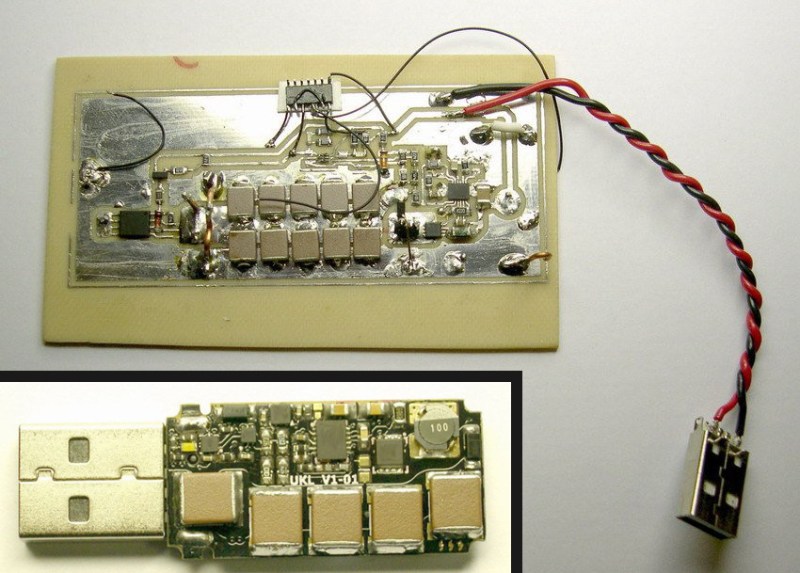[Dark Purple] recently heard a story about how someone stole a flash drive from a passenger on the subway. The thief plugged the flash drive into his computer and discovered that instead of containing any valuable data, it completely fried his computer. The fake flash drive apparently contained circuitry designed to break whatever computer it was plugged into. Since the concept sounded pretty amazing, [Dark Purple] set out to make his own computer-frying USB drive.
While any electrical port on a computer is a great entry point for potentially hazardous signals, USB is pretty well protected. If you short power and ground together, the port simply shuts off. Pass through a few kV of static electricity and TVS diodes safely shunt the power. Feed in an RF signal and the inline filtering beads dissipate most of the energy.
To get around or break through these protections, [Dark Purple]’s design uses an inverting DC-DC converter. The converter takes power from the USB port to charge a capacitor bank up to -110VDC. After the caps are charged, the converter shuts down and a transistor shunts the capacitor voltage to the data pins of the port. Once the caps are discharged, the supply fires back up and the cycle repeats until the computer is fried (typically as long as bus voltage is present). The combination of high voltage and high current is enough to defeat the small TVS diodes on the bus lines and successfully fry some sensitive components—and often the CPU. USB is typically integrated with the CPU in most modern laptops, which makes this attack very effective.
Thanks for the tip, [Pinner].

















http://memecrunch.com/meme/79695/dr-evil-pinky-think-of-that/image.jpg
Brilliant for making warranty claims on Laptops and TVs. Especially towards the end of warranty when you know they can’t replace parts cause its too old. They can only refund or upgrade.
Piezotransformer, simple driver and a timer. :-) I call it “Thor’s Hammer”.
Dumps 3000V via capacitor (2J) directly into the USB to overwhelm any possible antistatic protection and probably destroy the power supply for good measure.
This whole thing STINKS of BS!
First off, there is no such thing as a “n-channel field resistor” – WTF?
Second, I forwarded this to my father, an Electronics Engineer of 50+ years. He said, at best, his theory is “wacky”.
Simply put – no video/no schematic = BS!
Someone has already done something similar on Indiegogo
https://www.indiegogo.com/projects/usb-slayer
just found this case: P3A-210603L (New Age Enclosures oO)
Seen a lot of posts about someone finding this fake USB and then just plugging it in, and boom. Um, if you take the cover off, it’s pretty obviously not a normal USB.
I’d like to hear more about the actual device. How effective was it? How long did it take to begin to cause physical harm. Was there a precedence of components that were effected?
Nice idea, albeit a bit evil, does it work through a USB hub though?
Great Article. Thanks for the info. Does anyone know where I can find a blank RMA form to fill out?